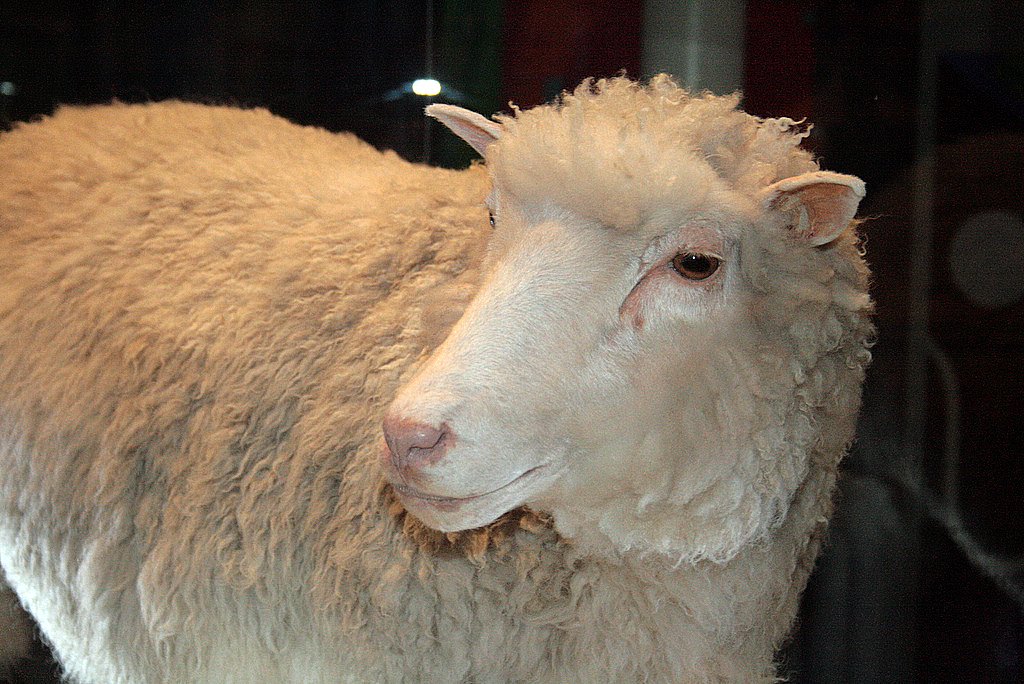A little bit more than 20 years ago, the first cloned mammal “Dolly the sheep” was born. It marked an important milestone for our abilities of genetic manipulation. A few years ago, scientists have also claimed that they are extremely close to cloning woolly mammoth, an already extinct animal, using gene sequencing. Our progress in biotechnology is nothing short of astonishing, and genetic modification has become a powerful tool in both art and science.
 |
| Dolly the sheep |
Genetic modification and animal research goes hand in hand in science. I have worked with mice with a genome coding for a certain neurotransmitter transporter knocked out to in order to study the effect of this neurotransmitter circuit in human. While animal right activists would argue otherwise, mice (and other experimental animals) serve as great models for humans and have enormous contribution to biological science advancements, potentially saving millions of people from various diseases.
 |
| Lab mice from the laboratory I work with. |
Eduardo Kac uses transgenic techniques to create his artwork “GFP Bunny”. It is worth noting that GFP (green fluorescence protein) is also widely used in fluorescence microscopy in scientific research. Kac claimed this piece of artwork represents a dialogue between art and science, and raises awareness towards transgenic animals that does not actually exist in nature. The concept of a “chimerical” animal is definitely novel. The GFP bunny itself is an epitome of human creativity and has proven life to be a valid expressive medium. I think the creation of this piece of artwork is also a successful scientific experiment and has its own scientific value as well as its artistic ones.
Another artist Kathy High creates the project “embracing animal," trying to extend the life of retired breeder mice by treating them holistically. While this project raised awareness towards animal treatment, I don’t believe it can be applied widely. A lot of animal breeders have certain genome removed that give them certain deficits. Extending these animal’s life might be putting them in more unnecessary pain.
I think both art and science should proceed cautiously with the powerful tools at hand. With the advancement of science we can practically “play God”. The scientific community already have a stringent guideline with regard to the use of genetic techniques and animal experimentation and I feel the artistic community definitely need one appropriate to its contribution and values as well.
At last I would like to recommend a movie called “Gattaca”. It is a science fiction movie in 1997 and the future that it depicted is within reach. With the great power we have at hand, we have greater ethical responsibilities and is in need of more comprehensive guidelines to guide our scientific research and artistic creations.
 |
| Gattaca (1997) |
Sources
1. "GFP BUNNY." GFP BUNNY. N.p., n.d. Web. 17 July 2016.
2. "The Politics of Empathy." Embracing Animal. N.p., n.d. Web. 17 July 2016.
3. "Woolly Mammoth Clones Closer Than Ever, Thanks to Genome Sequencing." LiveScience. TechMedia Network, n.d. Web. 17 July 2016.
Media:
1. "Dolly (sheep)." Wikipedia. Wikimedia Foundation, n.d. Web. 17 July 2016.
2. Photo taken by my coworker in lab.
3. "Gattaca (1997)." IMDb. IMDb.com, n.d. Web. 17 July 2016.
No comments:
Post a Comment